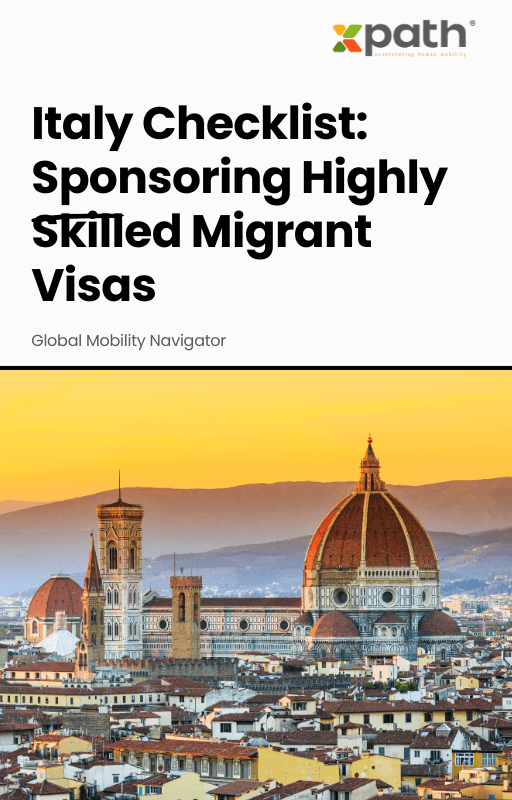Italy Checklist: Sponsoring Highly Skilled Migrant Visas
Grab a copy of a guide to international employee relocation
View E-bookAs businesses expand across borders, global mobility has become a critical factor for success. However, many organizations find themselves burdened by rising relocation costs, compliance challenges, and inefficiencies in their mobility programs. If your company is grappling with escalating expenses related to employee relocations, visas, and expatriate management, it’s time to rethink your strategy.
A cost-effective, well-structured global mobility plan can help businesses retain top talent, ensure compliance, and improve overall operational efficiency. In this article, we explore the reasons behind high mobility costs and actionable strategies to optimize your approach.
Global mobility expenses have skyrocketed, with the average international assignment costing companies between 1 million annually. These costs stem from:
🔸Fragmented vendor networks: Managing multiple providers for relocation, tax, immigration, and housing leads to inefficiencies and hidden fees.
🔸Compliance missteps: 47% of companies face penalties due to tax or immigration errors, according to a 2022 EY report.
🔸Over-reliance on long-term assignments: Inflexible “one-size-fits-all” policies often result in underutilized talent and unnecessary overhead.
🔸Lack of transparency: Manual processes and outdated tools obscure spending patterns, making cost optimization nearly impossible.
The pandemic exacerbated these challenges, accelerating demand for agile talent deployment. Companies clinging to legacy systems now risk falling behind competitors who leverage innovation to cut costs and enhance efficiency.
🔸Reactive, Not Proactive: Many programs operate in “firefighting” mode, addressing issues as they arise rather than anticipating needs through data.
🔸Technology Gaps: Spreadsheets and siloed software hinder collaboration and real-time decision-making.
🔸Employee Dissatisfaction: 60% of relocated employees cite poor support during transitions, leading to attrition and sunk costs.
🔸Sustainability Blind Spots: Carbon-heavy relocation practices clash with corporate ESG goals—and increasingly, employee expectations.
AI and cloud-based platforms are game-changers. For example, automated expense tracking tools reduce billing errors by 30%, while AI-powered chatbots streamline employee queries. Centralized dashboards offer real-time visibility into budgets, compliance status, and vendor performance, empowering managers to act swiftly.
Case in Point: A tech firm reduced relocation costs by 22% after implementing an AI-driven platform to predict assignment expenses and negotiate vendor rates dynamically.
Analytics transform raw data into actionable strategies. Predictive modeling can identify cost-saving opportunities, like opting for regional hubs over high-cost cities. Track metrics such as cost per assignment, employee satisfaction scores, and ROI on mobility investments to refine policies.
🔸Virtual Assignments: Remote work tools enable employees to contribute globally without relocation.
🔸Rotational Programs: Short-term or commuter assignments reduce housing and family support costs.
🔸Gig Mobility: Tap into contract workers for project-based roles, avoiding long-term commitments.
Invest in integrated compliance platforms that auto-update with local tax and immigration laws. Pre-assignment risk assessments can flag potential issues, while training programs ensure employees understand obligations.
Green initiatives aren’t just ethical—they’re economical. Encourage virtual collaboration over travel, select eco-friendly housing, and partner with carbon-offset programs. One Fortune 500 company cut relocation emissions by 40% while saving $15M annually through staggered assignments.
Collaborate with global mobility providers that offer end-to-end solutions, from visa processing to cultural training. Look for partners with localized expertise and scalable pricing models.
A multinational pharmaceutical company faced spiraling costs from inefficient relocations. By overhauling its strategy—adopting a unified tech platform, shifting to rotational assignments, and partnering with a sustainability-focused mobility firm—the company saved $12M in the first year while improving employee retention by 18%.
High costs aren’t inevitable—they’re a symptom of outdated practices. By integrating technology, data, and flexibility into your global mobility strategy, you can reduce expenses, mitigate risks, and future-proof your talent pipeline.
At xpath.global, we specialize in transforming mobility programs into strategic assets. Our AI-driven platform and global network of experts ensure seamless, cost-effective relocations tailored to your business goals.
Ready to slash costs and boost efficiency? Contact xpath.global today to schedule a free consultation.
How can companies reduce global mobility costs without compromising quality?
By using data-driven decision-making, optimizing vendor partnerships, and implementing flexible policies, companies can significantly cut costs while ensuring a positive employee experience.
What is a core-flex relocation policy?
A core-flex policy provides essential relocation services while allowing employees to choose additional benefits based on their needs, reducing unnecessary expenses.
How does technology help in global mobility cost management?
Advanced relocation platforms, AI-driven analytics, and automation tools can streamline processes, improve compliance, and provide real-time cost tracking.
What are the biggest hidden costs in global mobility?
Some of the most overlooked expenses include tax implications, visa processing, cultural training, and assignment failures.
Are hybrid mobility models cost-effective?
Yes. Hybrid mobility—combining remote work with occasional travel—helps businesses save on housing, relocation, and visa costs while maintaining global talent.
How can xpath.global help reduce mobility costs?
xpath.global provides integrated, tech-driven mobility solutions that optimize relocation budgets, enhance compliance, and improve employee satisfaction.
Ready to transform your mobility program? Explore xpath.global’s solutions.

Italy Checklist: Sponsoring Highly Skilled Migrant Visas
Grab a copy of a guide to international employee relocation
View E-book